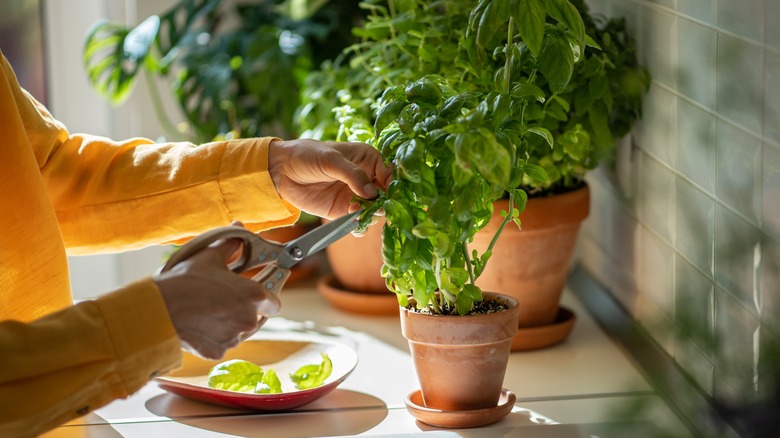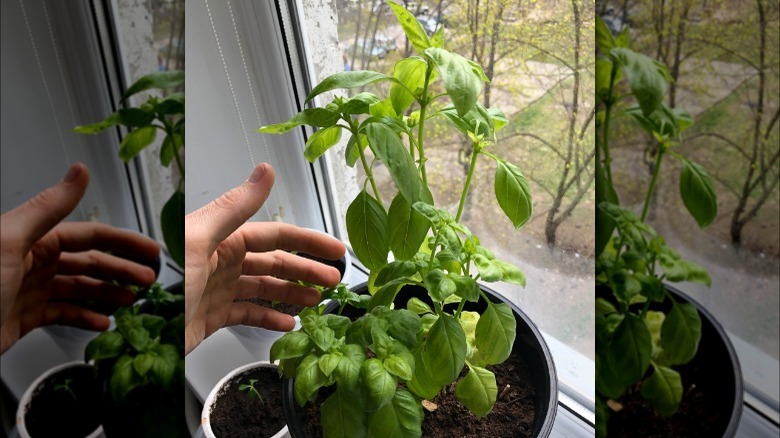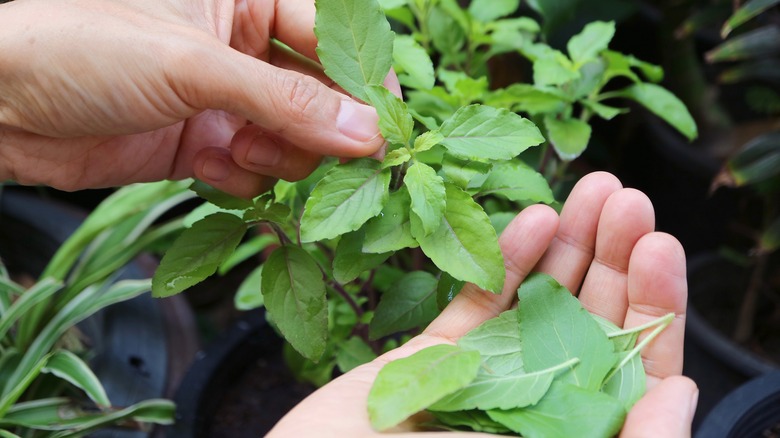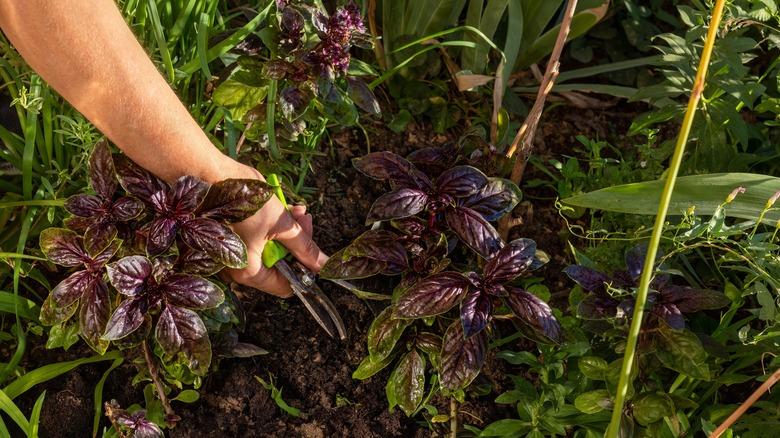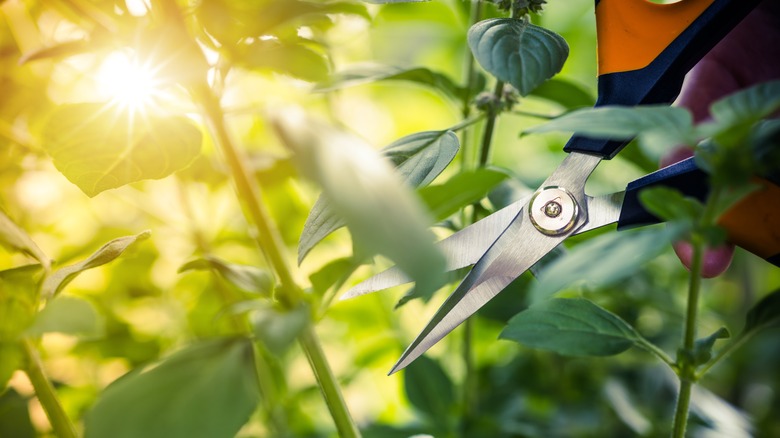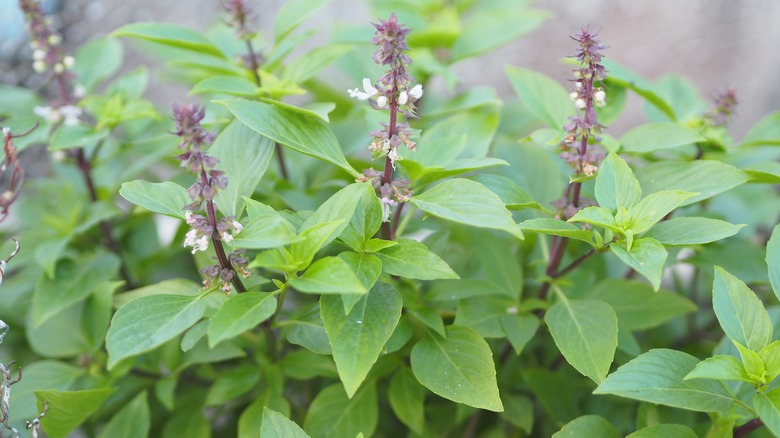Crucial Mistakes Everyone Makes When Pruning Basil
Basil is one of the most popular herbs to grow in a home garden. Depending on the variety, basil can produce sweet, spicy, or citrus-like aromas, and their leaves can also be used in a variety of recipes, saving you money and time as compared to buying pre-cut herbs at the grocery store. Other reasons you'll want to add basil to your garden include aesthetics, pollination, and possible natural pest control. Unfortunately, these benefits may be out of reach if you improperly prune your basil plants.
Pruning is an important chore a gardener must employ for a variety of plants, including basil. Not only does pruning your basil on a regular basis keep it looking healthy, but it will help ensure the plant continues to produce new leaves throughout the season. To that end, proper pruning timing and techniques are just as important for the life and productivity of a basil plant, as much as it is to ensure it gets full sun and adequate amounts of water. Knowing some of the most common pruning mistakes is key to a healthy basil plant.
Allowing basil plants to grow too tall
A basil plant that gets plenty of sunshine and regular water can grow quickly. However, you don't want your basil plant to grow too tall, as this may inherently decrease its girth and subsequent leaf production. It's one of the biggest mistakes people make when growing herbs, because it can also decrease air flow to the bottom of the plant and produce a leggy plant that may not survive as long as it otherwise could.
Pruning can help ensure your basil plant achieves a bushier, healthier shape. If you've grown basil from seed, you can start pruning once the plants grows 6 to 8 inches tall. This will help encourage the plant to produce more leaves throughout, rather than just on the top. However, even if your current plant has grown taller than you'd like, avoid taking off more than a third of its height at a time. Pruning more than this could inadvertently inhibit future growth.
Picking leaves from the bottom of basil plants
While you may occasionally pick basil leaves for cooking, as well as for harvesting and storing for later use, it's important to not solely take leaves from the bottom of your basil plants. Doing so can lower leaf growth production, and even make your plant appear leggy. Picking leaves from the bottom can also contribute to basil growing too tall, rather than a desired bushier shape.
Instead, always pick your basil leaves from the top of the plant and work your way down as needed. This approach will not only help keep the height of your basil plant in check, but the tops will also grow in quicker. You can pick leaves whenever you need them, even if it's just a few at a time. If you need more basil leaves at once, don't be afraid to cut off a whole stem, so long as you do so in the spaces right above two new ones. This method ensure that new growth will take place within one week of cutting.
Failing to follow a regular pruning schedule
Aside from picking and harvesting leaves as often as you need them, it's important to follow a regular pruning schedule to help support the life of your basil plant. You can still prune whenever you think the plant needs it, but having a schedule can also ensure basil doesn't get too tall and leggy. Plus, pruning your basil plant is key to maximum yield — while also ensuring better-tasting leaves — so you won't find yourself without leaves when you need them for culinary purposes.
As a rule of thumb, prune your basil plants once every two to three weeks during growing season. Consider putting this on your calendar or having a reminder set on your phone so you don't forget. It's also perfectly okay to prune in between scheduled sessions if you think your plant is getting too tall or if starts flowering. You can monitor individual branches to determine if they need pruning. Once a branch produces six or more leaves, prune it back to its first set.
Cutting basil in the wrong spots
Cutting at specific times isn't the only support practice for harvesting basil for more growth. What's equally important is the technique you use to prune basil. Both cutting the stems too close to the top of the plant and trimming off too much are equally detrimental to the overall health of your basil plant, leading to leggy branches and reduced leaf production.
The key to a proper pruning technique for basil plants involves identifying the nodes on the stems. These small points on the stems are essentially the intersections where the leaves attach to them. Once you've identified the nodes, take a small set of scissors and cut below them. Repeat this process on each stem you're pruning to help your basil plant grow more outward. During the hot summer months, you may also need to pick leaves more frequently, in addition to cutting basil stems at the nodes, as the plant may start leafing even more when temperatures exceed 80 degrees Fahrenheit.
Allowing the basil plant to produce flowers
Once basil plants grow taller and fuller, they have the capability of producing flowers. These can look quite attractive when they bloom, and grow in a range of pink, purple, and white colors, depending on the variety. However, most people don't want basil plants to flower, as this is a sign that the plant has not been pruned correctly. While not necessarily a problem from an aesthetic standpoint, the flowers can actually alter the taste of your basil leaves, which can be problematic if you use them for culinary purposes.
The best way to prevent basil plants from producing flowers is to follow a regular pruning schedule and to monitor them carefully for any signs of buds. On average, basil plants may produce flowers about six weeks after they grow their first set of six or more leaves. If you do see a green flower bud, cut it off to prevent further growth. Alternatively, if you don't use basil for cooking and aren't worried about potential bitter-tasting leaves, you can allow the flowers to grow and then cut the stems to create bouquets.
